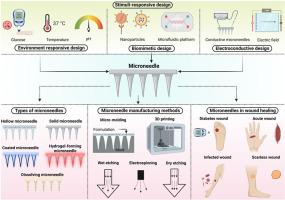微针阵列贴片的伤口愈合管理:迄今为止的旅程和未来的道路
IF 4.9
3区 医学
Q1 PHARMACOLOGY & PHARMACY
Journal of Drug Delivery Science and Technology
Pub Date : 2025-09-12
DOI:10.1016/j.jddst.2025.107522
引用次数: 0
摘要
微针已经成为伤口管理的前沿平台,为局部治疗和组织再生提供了微创方法。固体微针、空心微针、溶解微针和包覆微针系统在本综述中都进行了全面的介绍。它还讨论和检查结构参数,如长度,几何形状,材料选择如何影响治疗效率和患者舒适度。微针在糖尿病溃疡、外科伤口、烧伤、感染伤口和无疤痕伤口愈合中的应用突出了它们加速组织修复、减少并发症和改善患者预后的能力。这篇综述的新颖之处在于将材料设计的进步与新兴的智能功能相结合,包括生物传感微针和与生长因子、抗菌剂和纳米材料的组合策略。这些方法展示了将伤口护理从被动保护转变为主动引导治疗的潜力。尽管取得了显著进展,但仍存在一些知识空白。目前的系统面临着载药能力的限制,机械强度的可变性,以及平衡生物降解性和持续功能的挑战。此外,监管和转化障碍继续减缓临床应用。解决这些差距不仅需要优化制造技术,如增材制造,还需要严格评估生物相容性、安全性和长期性能。展望未来,未来的发展方向是开发能够实时监测伤口、环境响应药物释放、与数字健康平台集成的多功能微针。这些创新代表了在现代伤口治疗中实现精确、适应性和可扩展性的有前途的下一代策略。本文章由计算机程序翻译,如有差异,请以英文原文为准。

Wound healing management using microneedle array patch: Journey so far and road ahead
Microneedles have emerged as a cutting-edge platform in wound management, offering minimally invasive approaches for localized therapy and tissue regeneration. The solid, hollow, dissolving, and coated microneedle systems are all thoroughly covered in this review. It is also discuss and examine how structural parameters such as length, geometry, material choice that influence therapeutic efficiency and patient comfort. Microneedles applications in diabetic ulcers, surgical wounds, burn injuries, infected wounds, and scarless wound healing highlight their ability to accelerate tissue repair, minimize complications, and improve patient outcomes. The novelty of this review lies in integrating advances in material design with emerging smart functionalities, including biosensing-enabled microneedles and combinatorial strategies with growth factors, antimicrobials, and nanomaterials. These approaches demonstrate the potential to transform wound care from passive protection to actively guided therapy. Despite notable progress, several knowledge gaps remain. Current systems face limitations in drug-loading capacity, variability in mechanical strength, and challenges in balancing biodegradability with sustained functionality. Moreover, regulatory and translational barriers continue to slow clinical adoption. Addressing these gaps requires not only optimization of fabrication technologies such as additive manufacturing but also rigorous evaluation of biocompatibility, safety, and long-term performance. Looking ahead, future directions emphasize the development of multifunctional microneedles capable of real-time wound monitoring, environment-responsive drug release, and integration with digital health platforms. Such innovations represent promising next-generation strategies to achieve precision, adaptability, and scalability in modern wound therapy.
求助全文
通过发布文献求助,成功后即可免费获取论文全文。
去求助
来源期刊
CiteScore
8.00
自引率
8.00%
发文量
879
审稿时长
94 days
期刊介绍:
The Journal of Drug Delivery Science and Technology is an international journal devoted to drug delivery and pharmaceutical technology. The journal covers all innovative aspects of all pharmaceutical dosage forms and the most advanced research on controlled release, bioavailability and drug absorption, nanomedicines, gene delivery, tissue engineering, etc. Hot topics, related to manufacturing processes and quality control, are also welcomed.

 求助内容:
求助内容: 应助结果提醒方式:
应助结果提醒方式:


